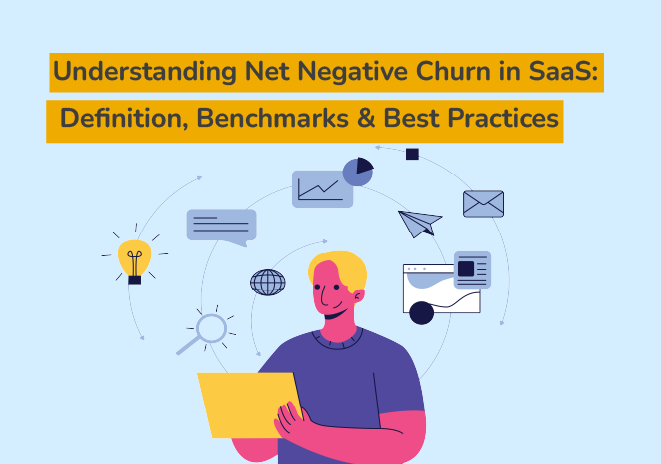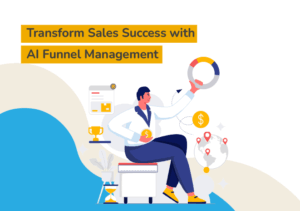What is Net Negative Churn?
Net negative churn is a paramount metric in the Software as a Service (SaaS) industry, indicative when revenue gains from existing customer expansions surpass revenue lost from churned customers. Unlike traditional churn that focuses on lost customers, net negative churn emphasizes growth through existing customer engagement. Attaining net negative churn is crucial for SaaS companies as it signifies a healthy, scalable business model, minimizing dependency on acquiring new users constantly. This strategy allows businesses not only to retain customers but also to enhance profitability aggressively through upselling and cross-selling strategies, driving long-term success.
Key Takeaways
- Net negative churn is vital in the SaaS industry as it highlights revenue gains from existing customer expansions surpassing losses from churned customers.
- Unlike traditional churn, which focuses on lost customers, net negative churn emphasizes growth through engagement with current customers.
- Achieving net negative churn is crucial for SaaS businesses, as it indicates scalable growth and increased profitability.
- Key metrics for calculating net negative churn include Monthly Recurring Revenue (MRR) lost and gained from existing customer expansions.
- Overcoming challenges in maintaining net negative churn involves enhancing customer engagement and leveraging strategic upselling and cross-selling.
- SaaS companies should target net negative churn rates of -5% to -10%, reflecting robust customer loyalty and retention.
- Personalization and customer success strategies are essential for sustaining net negative churn and driving long-term growth.
How is net negative churn different from traditional churn?
The concept of
net negative churn marks a key differentiator in the realm of SaaS business metrics when compared to traditional churn. While traditional churn focuses on the percentage loss in revenue or customers, net negative churn takes this a step further by emphasizing not just retention but also enhancing revenue through existing customers. Achieving net negative churn implies that any lost revenue from churned customers is outpaced by revenue gained via expansions, upsells, and cross-sells. This metric is crucial for sustainable growth as it ensures a SaaS business isn’t just maintaining the status quo but actively advancing its revenue streams.
„Unlike traditional churn, which accounts for customer loss, net negative churn emphasizes revenue growth from existing clientele. Achieving it means revenue growth surpasses losses, typically through expansions and upsells.“
Why is net negative churn important for SaaS businesses?
Net
negative churn is a crucial metric for SaaS companies as it indicates that revenue expansion from existing customers surpasses the revenue lost from customers who churn. This positive revenue growth is vital because it reflects a business’s ability to not only retain its customer base but also extract higher value over time. Companies with net negative churn experience
increased profitability and stability, making them more attractive to investors and stakeholders. Moreover, by focusing on increasing the value provided to existing customers, SaaS companies can achieve sustainable growth and maintain a competitive edge in the market.
- Importance for revenue growth
- Enhances customer lifetime value
- Attracts investors
How is Net Negative Churn Calculated?
Calculating
net negative churn is crucial for SaaS businesses aiming to foster continuous growth. The formula involves assessing the total revenue lost from downgraded or canceled subscriptions within a specific period and comparing it with the revenue gained from
upsells, cross-sells, and other expansions. Essential metrics for this calculation include
MRR (Monthly Recurring Revenue) lost, MRR gained from existing customers, and the percentage change. This comprehensive view helps understand the impact on overall revenue. Accurate measurement not only guides strategic decisions but also highlights the effectiveness of retention efforts, ensuring businesses adapt to changing customer needs and preferences.
What formula is used to calculate net negative churn?
Calculating net negative churn is fundamental for Software as a Service (SaaS) business success. The formula involves subtracting the revenue lost from customer churn from the revenue gained through expansions—such as
upgrades,
add-ons, and
cross-sells—within the existing customer base. This balance can result in less revenue loss than gained, transforming churn into an opportunity for growth. Essential metrics include Customer Lifetime Value (CLV) and Expansion Revenue Rate. Mastering this formula provides a realistic picture of financial health and sets a benchmark for strategic growth initiatives without continually acquiring new customers.
What metrics are essential for calculating net negative churn?
To accurately calculate
net negative churn, several key
metrics are essential. The baseline metric includes the
Annual Recurring Revenue (ARR) or
Monthly Recurring Revenue (MRR). It’s also crucial to track
expansion revenue from existing customers, which includes upselling and cross-selling. Additionally, understanding customer
retention rates and
contraction revenue—the loss from downgrades or cancellations—is vital. Consolidating these metrics helps SaaS businesses maintain a net negative churn status, fostering
financial growth and
customer loyalty. Accurate
data analysis of these factors leads to actionable insights for long-term strategy implementation.
How Does Net Negative Churn Impact Growth?
Net negative churn serves as a powerful engine for
revenue growth in SaaS businesses. Unlike traditional churn, where revenue drains due to customer attrition, net negative churn occurs when the additional revenue from
existing customers—via upselling or cross-selling—outweighs the lost revenue from churned accounts. This dynamic not only highlights the role of
customer retention in revenue expansion but also illustrates how maximizing customer value enhances financial stability. As existing customers deepen their
engagement with a company’s offerings, the business enjoys a compounded positive impact, fostering enduring growth and resilience in a competitive landscape.
How can net negative churn drive revenue growth?
Net negative churn is a significant growth driver for SaaS businesses, reflecting scenarios where
expansion revenue from existing customers surpasses the
revenue lost through churn. This phenomenon not only offsets losses but also enhances overall
revenue growth without acquiring new customers. By focusing on
upselling and
cross-selling, companies can increase the lifetime value of their customer base, turning churn threats into opportunities for expansion. Retaining existing customers and expanding revenue within that cohort prove cost-effective and efficient, laying the groundwork for sustainable growth.
What role does net negative churn play in customer retention?
Net negative churn plays a pivotal role in customer retention by not only counteracting revenue loss from departing subscribers but also enhancing overall growth through existing customer expansion. By increasing the value customers gain from services, SaaS companies retain them longer, leading to higher customer lifetime value. As businesses focus on effectively serving their existing clients through tailored offerings and exceptional service, they foster loyalty and satisfaction. This improved customer satisfaction cultivates a stable revenue stream that boosts business sustainability and facilitates long-term success. Ultimately, achieving net negative churn signifies a healthy, growing customer base.
What are the Industry Benchmarks for Net Negative Churn?
In the competitive world of
Software as a Service (SaaS), understanding industry benchmarks for
net negative churn is vital. On average, SaaS companies strive for a net negative churn rate between
-5% to -10%, indicating customers are spending more over time than the revenue lost from departing customers. A low or negative churn signifies robust
customer loyalty and retention. Measuring performance against these benchmarks allows businesses to assess their growth strategies effectively. Companies must consistently evaluate their
expansion revenue from existing clients to ensure they are trending toward optimal churn levels.
What are the average net negative churn rates in SaaS?
Understanding the
average net negative churn rates in SaaS is crucial for benchmarking
business performance. Typically, successful SaaS companies aim for net negative churn rates ranging from
-5% to -15% annually. This indicates that additional revenue from existing customers outpaces revenue lost to churn. Keeping net negative churn in check allows businesses to focus on
expansion rather than replacement. Monitoring
current trends and
peer benchmarks ensures a company’s strategy aligns with industry standards. Prioritizing these rates helps maintain a competitive edge and guides SaaS firms in achieving sustainable growth.
How should SaaS companies measure their net negative churn performance?
SaaS companies should meticulously measure their
net negative churn performance to ensure ongoing business success. This involves regularly assessing key metrics such as
customer acquisition cost (CAC) and
customer lifetime value (CLV). Benchmarking against
industry standards helps in establishing realistic targets, while tracking customer upsells and cross-sells highlights revenue growth opportunities. Using real-time
analytics and reporting tools can offer insights into churn trends and help refine customer retention strategies, fostering an environment conducive to achieving net negative churn — where recurring revenue outweighs any revenue lost from churned customers.
What Strategies Lead to Achieving Net Negative Churn?
Net negative churn is a powerful metric that can significantly enhance a SaaS company’s growth trajectory by exceeding lost revenue with expansions and upgrades. Key strategies involve prioritizing
upselling and cross-selling to existing customers, thereby maximizing lifetime value. These approaches not only offset churn but also fuel sustainable revenue growth. Furthermore, implementing
customer success strategies is crucial—focusing on increasing user engagement and satisfaction can preempt potential churn. Understanding customer needs and delivering value proactively fosters long-term retention, leading to optimal net negative churn outcomes. Dedicated effort in these areas can position SaaS companies favorably in competitive markets.
How does upselling and cross-selling contribute to net negative churn?
Upselling and cross-selling are integral tactics for achieving net negative churn in SaaS businesses. These strategies not only enhance the customer experience but also significantly boost revenue. By offering additional services or upgrades that add value to the existing purchase, companies can increase the Customer Lifetime Value (CLV). This increase can offset customer losses and exceed any revenue lost to churn, thereby leading to a net positive revenue growth. These techniques convert existing customers into more profitable ones, reinforcing retention while simultaneously empowering businesses to thrive in competitive markets.
What customer success strategies are effective for reducing churn?
Customer success is central to reducing churn in SaaS businesses. By proactively addressing customer needs through personalized support and resource allocation, companies can bolster customer loyalty. Implementing comprehensive
onboarding processes ensures customers understand and fully utilize products, mitigating potential dissatisfaction. Regular check-ins and feedback loops allow businesses to identify issues early and adapt services to maintain relevance. Additionally, offering
value-driven solutions through tailored
upselling and
cross-selling increases customer lifetime value. These strategies not only enhance the customer experience but also drive consistent growth by minimizing churn rates, establishing a solid foundation for fostering enduring relationships.
What Challenges Exist in Maintaining Net Negative Churn?
SaaS companies striving for net negative churn often encounter several challenges that require strategic navigation. This critical metric not only reflects a business’s ability to retain customers but also its effectiveness in growing revenues despite customer losses. The primary hurdles include inadequate customer engagement, insufficient focus on upselling, and a lack of robust customer success programs. Understanding these obstacles is crucial for businesses aiming to enhance their recurring revenue stream. Addressing these issues through detailed analytics and personalized customer interactions can significantly improve net negative churn, positioning companies for sustainable growth.
Why do some companies struggle with achieving net negative churn?
Many
SaaS companies struggle with achieving net negative churn due to insufficient focus on
customer success strategies and loyalty programs. Without a clear understanding of customer needs, businesses may
neglect upselling and cross-selling opportunities, which are integral to achieving net negative churn. Additionally, companies often lack the necessary
analytics tools to predict churn and proactively address customer concerns. A disconnection between product development and customer feedback can also impede creating a customer-centric experience. Finally, limited
personalization efforts can fail to foster lasting customer relationships, making it difficult to achieve sustainable growth.
How can SaaS businesses overcome these challenges?
SaaS businesses often face challenges in maintaining net negative churn, which is crucial for sustainable growth. Overcoming these challenges requires a strategic focus on customer retention and leveraging analytics for insights into customer behavior. Additionally, investing in personalization, ensuring seamless user experiences, and fostering strong customer relationships through continuous engagement can help mitigate common issues. It’s essential to proactively address the reasons for churn, such as lacking features or support, by developing targeted solutions. Streamlined upselling and cross-selling strategies also play a vital role in enhancing net negative churn.
What are the Best Practices for Sustaining Net Negative Churn?
Sustaining
net negative churn in a SaaS business requires a blend of strategic operations and tactical execution. Personalization is key; understanding and catering to individual customer needs can significantly enhance
customer retention. Utilizing analytics allows businesses to identify upselling and cross-selling opportunities, fostering deeper engagements and increased satisfaction. Continuous feedback loops and targeted interventions help anticipate and address potential churn triggers. Additionally, investing in a
customer success team ensures proactive support, promoting loyalty and an ongoing relationship with your brand. Collectively, these practices not only sustain net negative churn but also drive long-term growth and profitability.
How can personalization improve customer retention?
Personalization is a key tactic in enhancing customer retention in the SaaS landscape. By providing tailored experiences, businesses can deepen relationships with their customers, leading to increased satisfaction and loyalty. Personalized communication and offers can foster a stronger connection with consumers, encouraging them to continue using services and explore additional products. This approach not only reduces churn rates but also boosts lifetime value. Prioritizing personalization helps SaaS companies differentiate themselves from competitors, creating a seamless and engaging customer journey. With effective use of data and behavioral insights, personalization becomes a powerful tool for achieving net negative churn.
What role does analytics play in maintaining net negative churn?
Analytics plays a pivotal role in sustaining net negative churn by providing data-driven insights that inform strategic decisions. By analyzing customer behavior, SaaS businesses can identify key trends and patterns, enabling them to tailor their efforts to improve customer experience and increase customer lifetime value. Utilizing predictive analytics can help forecast potential churn risks and personalize engagement strategies. Moreover, deep analytics facilitates effective monitoring of upselling and cross-selling opportunities and evaluates the effectiveness of customer success initiatives, thus encouraging continuous improvement. Ultimately, leveraging analytics helps in maintaining a robust framework for achieving sustainable net negative churn.
| Key Benefits of Analytics in Maintaining Net Negative Churn |
| Identifies customer behavior trends |
| Predictive analytics for potential churn |
| Monitors upselling & cross-selling opportunities |
| Evaluates customer success effectiveness |
| Personalizes engagement strategies |
FAQ
What is net negative churn?
Net negative churn is a metric in the SaaS industry indicating revenue growth from existing customer expansions that exceed revenue lost from churned customers.
How is net negative churn different from traditional churn?
Traditional churn focuses on lost customers, whereas net negative churn emphasizes revenue growth through existing customer engagement and surpassing lost revenue through expansions.
Why is net negative churn important for SaaS businesses?
Net negative churn is crucial as it shows revenue expansion from existing customers, leading to increased profitability and stability, attracting investors and enabling sustainable growth.
How is net negative churn calculated?
Net negative churn is calculated by subtracting revenue lost from churned customers from revenue gained through upsells, cross-sells, and other expansions within a specific period.
What challenges exist in maintaining net negative churn?
Challenges include inadequate customer engagement, insufficient upselling strategies, and lack of strong customer success programs, which can impede revenue growth despite churn.
How can SaaS businesses overcome challenges in maintaining net negative churn?
SaaS businesses can overcome challenges by focusing on customer retention, leveraging analytics, and enhancing personalization and upselling strategies.
What is the importance of upselling and cross-selling in net negative churn?
Upselling and cross-selling are crucial as they boost revenue and customer lifetime value, offsetting losses and achieving net positive revenue growth.
What are the average net negative churn rates in SaaS?
Successful SaaS companies aim for net negative churn rates ranging from -5% to -15% annually, indicating revenue growth from existing customers outweighs revenue lost to churn.
What role does analytics play in maintaining net negative churn?
Analytics provides data-driven insights to inform strategic decisions, identifying customer behavior trends, monitoring upselling opportunities, and forecasting potential churn.









